PARSIPPANY, N.J., July 31, 2023 – Avis Budget Group, Inc. (NASDAQ: CAR) announced financial results for second quarter 2023 today.
We ended the quarter with revenues of $3.1 billion, driven by strong demand and seasonal revenue per day increase.
Net income was $436 million and our Adjusted EBITDA1 was $737 million. Utilization was up 50 basis points compared to second quarter 2022, at 70.5%, as our fleet continues to be well positioned to meet growing demand.
Our liquidity position at the end of the quarter was approximately $1.1 billion, with an additional $1.1 billion of fleet funding capacity. We have well-laddered corporate debt, and after giving effect to our euro note repayment in September 2023, will have no meaningful maturities until mid-2025.
“Our strong second quarter results continued to showcase the earnings power of our Company. These results reflect the hard work of our team and their exceptional ability to capitalize on a strong and increasing travel demand environment,” said Joe Ferraro, Avis Budget Group Chief Executive Officer. “Summer travel has continued to be robust with elevated peak period demand and seasonally improved pricing. Our teams remain focused and ready as we transition into our busiest season of the year.”
Q2 HIGHLIGHTS
• Revenues were $3.1 billion with rental days up 4% compared to second quarter 2022.
• Adjusted EBITDA in the Americas was $631 million, driven by strong demand and improved utilization.
• Adjusted EBITDA in International was $126 million, driven by strong seasonally increasing volume.
• Voluntary cash contribution of nearly $400 million to vehicle programs in the quarter.
• In July 2023, we issued €400 million Senior Notes due July 2030 primarily to redeem our outstanding €300 million Senior Notes due November 2024.
1 Adjusted EBITDA and certain other measures in this release are non-GAAP financial measures. See “Non-GAAP Financial Measures and Key Metrics” and the tables that accompany this release for the definitions and reconciliations of these non-GAAP measures to the most comparable GAAP measures.
INVESTOR CONFERENCE CALL
We will host a conference call to discuss our second quarter results on August 1, 2023, at 8:30 a.m. (ET). Investors may access the call on our investor relations website at ir.avisbudgetgroup.com or by dialing (877) 407-2991 and a replay of the call will be available on our website and at (877) 660-6853 using conference code 13739954.
ABOUT AVIS BUDGET GROUP
We are a leading global provider of mobility solutions, both through our Avis and Budget brands, which have more than 10,000 rental locations in approximately 180 countries around the world, and through our Zipcar brand, which is the world’s leading car sharing network. We operate most of our car rental locations in North America, Europe and Australasia directly, and operate primarily through licensees in other parts of the world. We are headquartered in Parsippany, N.J. More information is available at avisbudgetgroup.com.
NON-GAAP FINANCIAL MEASURES AND KEY METRICS
This release includes financial measures such as Adjusted EBITDA and Adjusted Free Cash Flow, as well as other financial measures, that are not considered generally accepted accounting principle (“GAAP”) measures as defined under SEC rules. Important information regarding such non-GAAP measures is contained in the tables within this release and in Appendix I, including the definitions of these measures and reconciliations to the most comparable GAAP measures.
We measure performance principally using the following key metrics: (i) rental days, (ii) revenue per day, (iii) vehicle utilization, and (iv) per-unit fleet costs. Our rental days, revenue per day and vehicle utilization metrics are all calculated based on the actual rental of the vehicle during a 24-hour period. We believe that this methodology provides management with the most relevant metrics in order to effectively manage the performance of our business. Our calculations may not be comparable to the calculations of similarly-titled metrics by other companies. We present currency exchange rate effects on our key metrics to provide a method of assessing how our business performed excluding the effects of foreign currency rate fluctuations. Currency exchange rate effects are calculated by translating the current-period’s results at the prior-period average exchange rates plus any related gains and losses on currency hedges.
FORWARD-LOOKING STATEMENTS
Certain statements in this press release constitute “forward-looking statements” as that term is defined in the Private Securities Litigation Reform Act of 1995. The forward-looking statements contained herein are subject to known and unknown risks, uncertainties, assumptions and other factors that may cause our actual results, performance or achievements to be materially different from those expressed or implied by any such forward- looking statements. Forward-looking statements include information concerning our future financial performance, business strategy, projected plans and objectives. These statements may be identified by the fact that they do not relate to historical or current facts and may use words such as “believes,” “expects,” “anticipates,” “will,” “should,” “could,” “may,” “would,” “intends,” “projects,” “estimates,” “plans,” “forecasts,” “guidance,” and similar words, expressions or phrases. The following important factors and assumptions could affect our future results and could cause actual results to differ materially from those expressed in such forward-looking statements. These factors include, but are not limited to:
- the high level of competition in the mobility industry, including from new companies or technology, and the impact such competition may have on pricing and rental volume;
- a change in our fleet costs, including as a result of a change in the cost of new vehicles, resulting from inflation or otherwise, manufacturer recalls, disruption in the supply of new vehicles, shortages in semiconductors used in new vehicle production, and/or a change in the price at which we dispose of used vehicles either in the used vehicle market or under repurchase or guaranteed depreciation programs;
- the results of operations or financial condition of the manufacturers of our vehicles, which could impact their ability to perform their payment obligations under our agreements with them, including repurchase and/or guaranteed depreciation arrangements, and/or their willingness or ability to make vehicles available to us or the mobility industry as a whole on commercially reasonable terms or at all;
- levels of and volatility in travel demand, including future volatility in airline passenger traffic;
- a deterioration in economic conditions, resulting in a recession or otherwise, particularly during our peak
season or in key market segments; - an occurrence or threat of terrorism, the current and any future pandemic diseases, natural disasters, military conflict, including the ongoing military conflict between Russia and Ukraine, or civil unrest in the locations in which we operate, and the potential effects of sanctions on the world economy and markets and/or international trade;
- any substantial changes in the cost or supply of fuel, vehicle parts, energy, labor or other resources on which we depend to operate our business, including as a result of COVID-19, inflation, the ongoing military conflict between Russia and Ukraine, and any embargos on oil sales imposed on or by the Russian government;
- our ability to continue to successfully implement or achieve our business plans and strategies, achieve and maintain cost savings and adapt our business to changes in mobility;
- political, economic or commercial instability in the countries in which we operate, and our ability to conform to multiple and conflicting laws or regulations in those countries;
- our ability to dispose of vehicles in the used-vehicle market on attractive terms;
- our dependence on third-party distribution channels, third-party suppliers of other services and co-marketing arrangements with third parties;
- risks related to completed or future acquisitions or investments that we may pursue, including the incurrence of incremental indebtedness to help fund such transactions and our ability to promptly and effectively integrate any acquired businesses or capitalize on joint ventures, partnerships and other investments;
- our ability to utilize derivative instruments, and the impact of derivative instruments we utilize, which can be affected by fluctuations in interest rates, gasoline prices and exchange rates, changes in government regulations and other factors;
- our exposure to uninsured or unpaid claims in excess of historical levels and our ability to obtain insurance at desired levels and the cost of that insurance;
- risks associated with litigation or governmental or regulatory inquiries, or any failure or inability to comply with laws, regulations or contractual obligations or any changes in laws, regulations or contractual obligations, including with respect to personally identifiable information and consumer privacy, labor and employment, and tax;
- risks related to protecting the integrity of, and preventing unauthorized access to, our information technology systems or those of our third-party vendors, licensees, dealers, independent operators and independent contractors, and protecting the confidential information of our employees and customers against security breaches, including physical or cybersecurity breaches, attacks, or other disruptions, compliance with privacy and data protection regulation, and the effects of any potential increase in cyberattacks on the world economy and markets and/or international trade;
- any impact on us from the actions of our third-party vendors, licensees, dealers, independent operators and independent contractors and/or disputes that may arise out of our agreements with such parties;
- any major disruptions in our communication networks or information systems;
- risks related to tax obligations and the effect of future changes in tax laws and accounting standards;
- risks related to our indebtedness, including our substantial outstanding debt obligations, recent and future interest rate increases, which increase our financing costs, downgrades by rating agencies and our ability to incur substantially more debt;
- our ability to obtain financing for our global operations, including the funding of our vehicle fleet through the issuance of asset-backed securities and use of the global lending markets;
- our ability to meet the financial and other covenants contained in the agreements governing our indebtedness, or to obtain a waiver or amendment of such covenants should we be unable to meet such covenants;
- significant changes in the assumptions and estimates that are used in our impairment testing for goodwill or intangible assets, which could result in a significant impairment of our goodwill or intangible assets; and
- other business, economic, competitive, governmental, regulatory, political or technological factors affecting our operations, pricing or services.
We operate in a continuously changing business environment and new risk factors emerge from time to time. New risk factors, factors beyond our control, or changes in the impact of identified risk factors may cause actual results to differ materially from those set forth in any forward-looking statements. Accordingly, forward-looking statements should not be relied upon as a prediction of actual results. Moreover, we do not assume responsibility if future results are materially different from those forecasted or anticipated. Other factors and assumptions not identified above, including those discussed in “Management’s Discussion and Analysis of Financial Condition and Results of Operations,” in Item 2 and “Risk Factors” in Item 1A in our quarterly report and in similarly titled sections set forth in Item 7 and in Item 1A and in other portions of our 2022 Annual Report on Form 10-K filed with the Securities and Exchange Commission on February 16, 2023 (the “2022 Form 10-K”), may cause actual results to differ materially from those projected in any forward-looking statements.
Although we believe that our assumptions are reasonable, any or all of our forward-looking statements may prove to be inaccurate and we can make no guarantees about our future performance. Should unknown risks or uncertainties materialize or underlying assumptions prove inaccurate, actual results could differ materially from past results and/or those anticipated, estimated or projected. We undertake no obligation to release any revisions to any forward-looking statements, to report events or to report the occurrence of unanticipated events. For any forward-looking statements contained in any document, we claim the protection of the safe harbor for forward- looking statements contained in the Private Securities Litigation Reform Act of 1995. For additional information concerning forward-looking statements and other important factors, refer to our most recent Annual Report on Form 10-K, Quarterly Reports on Form 10-Q and other filings with the Securities and Exchange Commission (the “SEC”).
Investor Relations Contact:
David Calabria, IR@avisbudget.com
Media Relations Contact:
James Tomlinson, ABGPress@edelman.com
*** Tables 1 – 6 and Appendix I attached ***
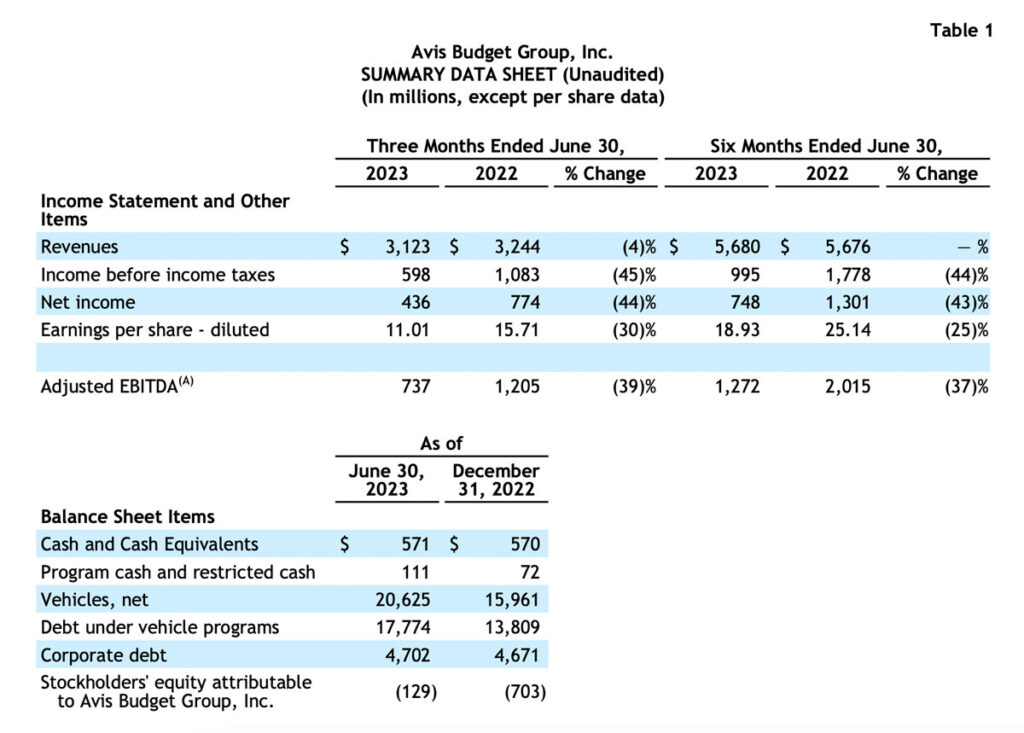
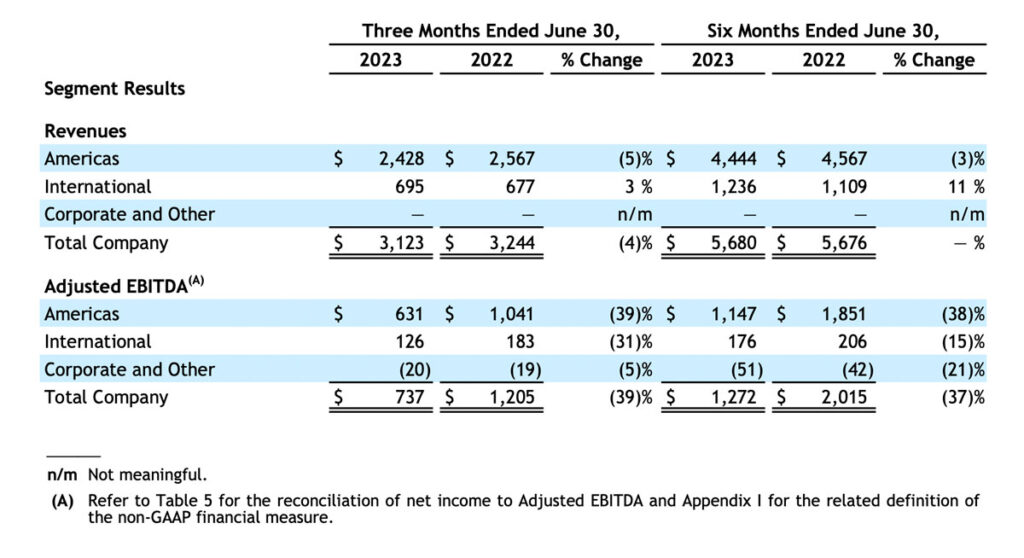

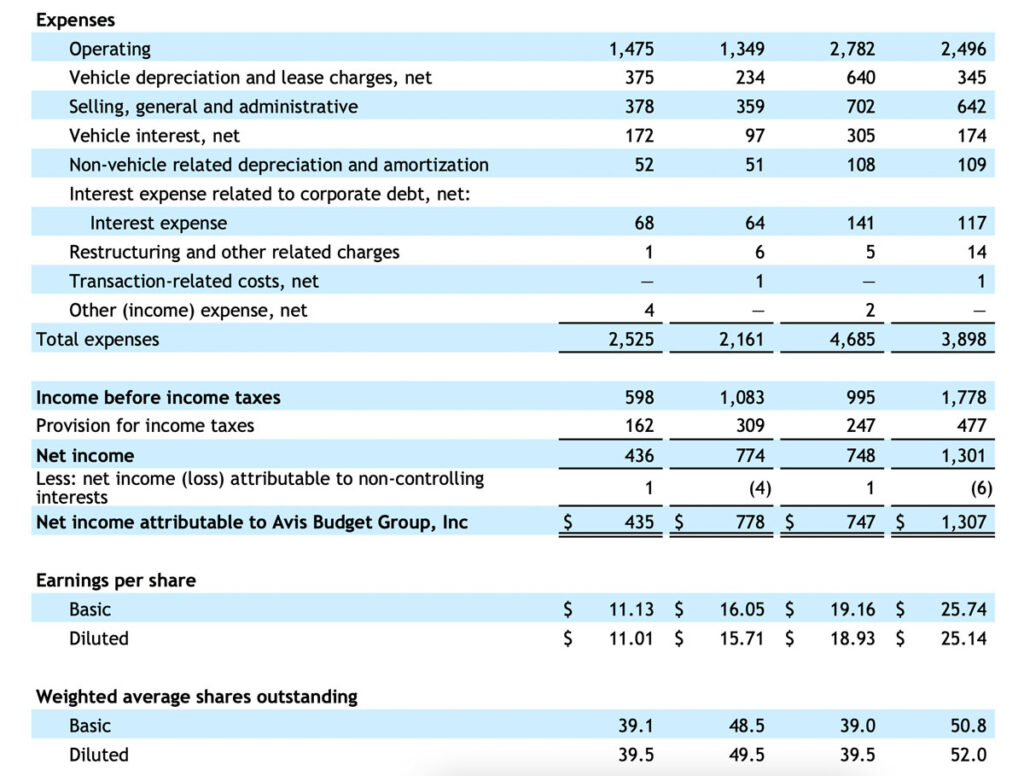
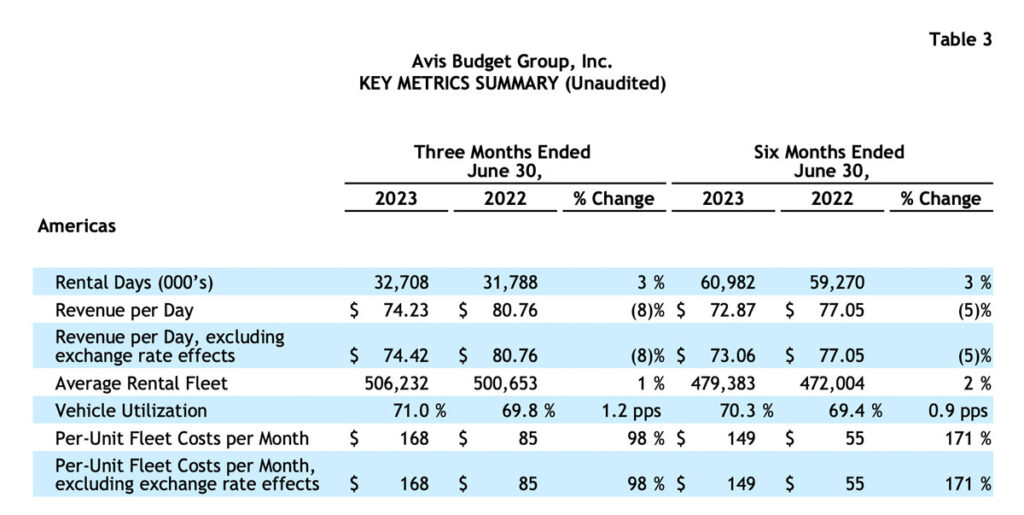
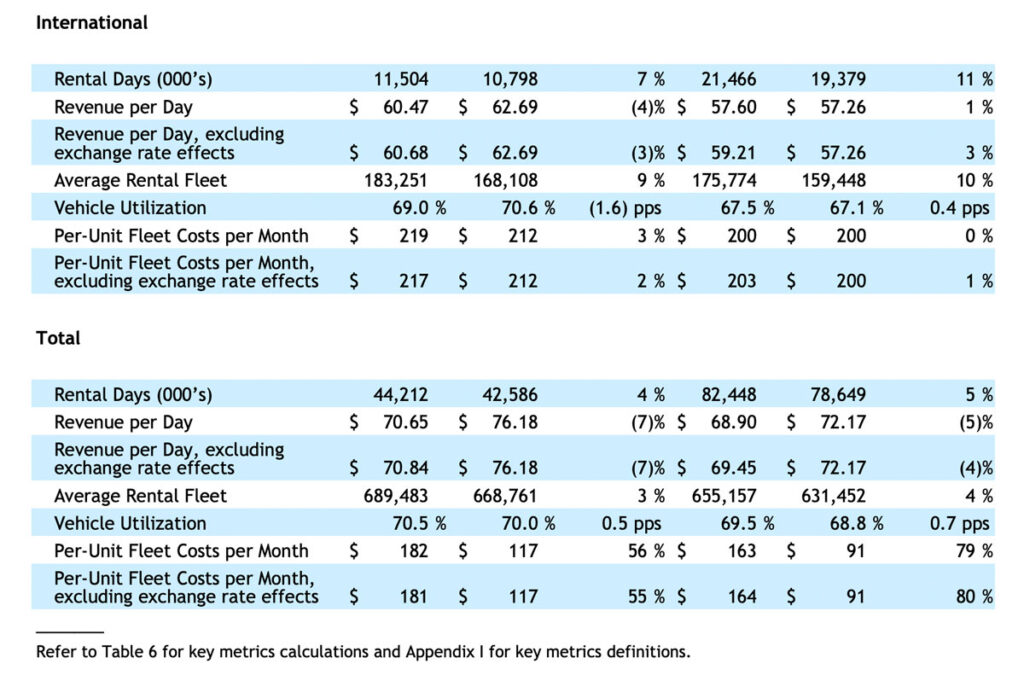
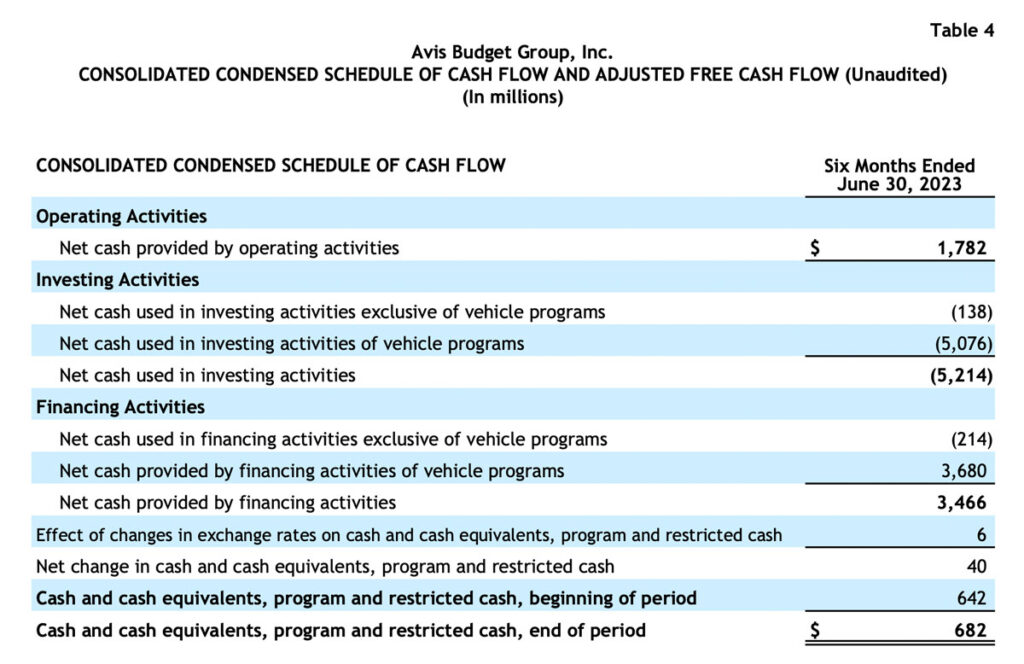
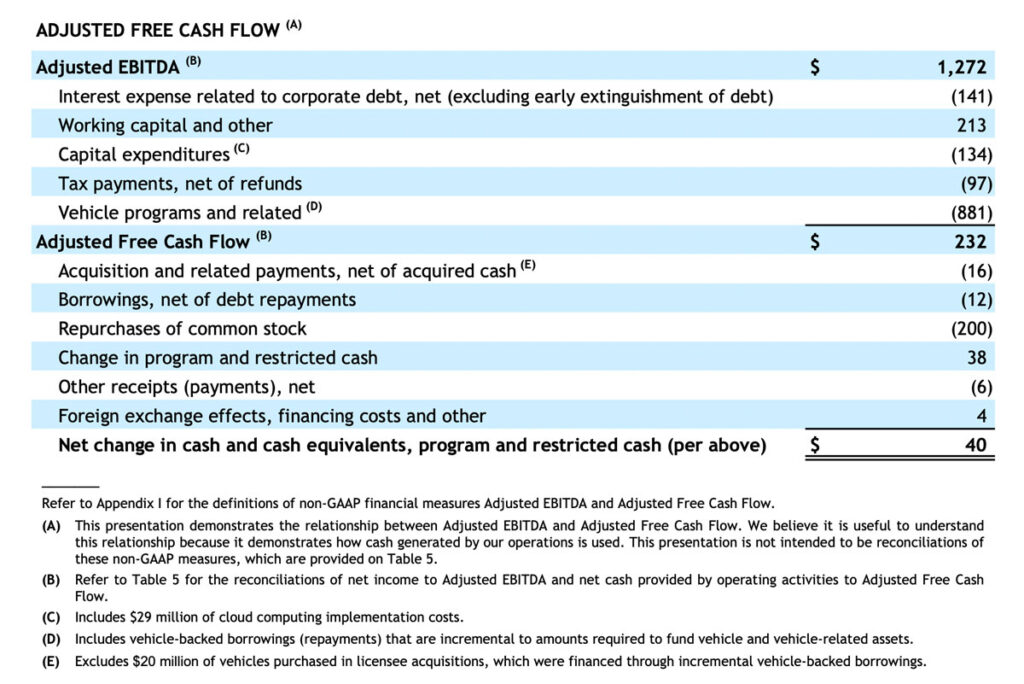
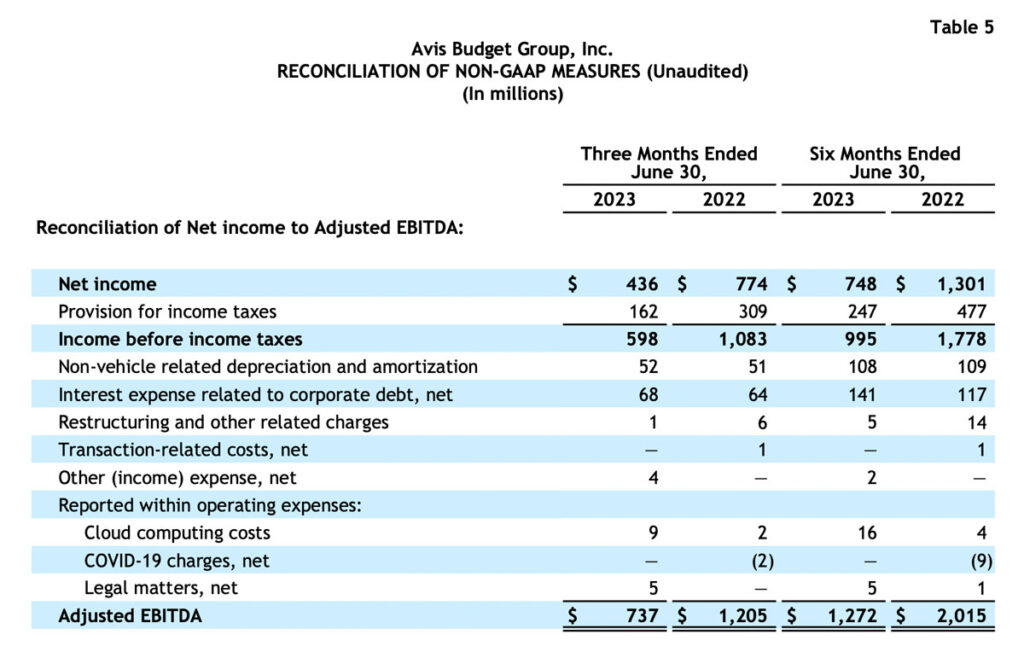
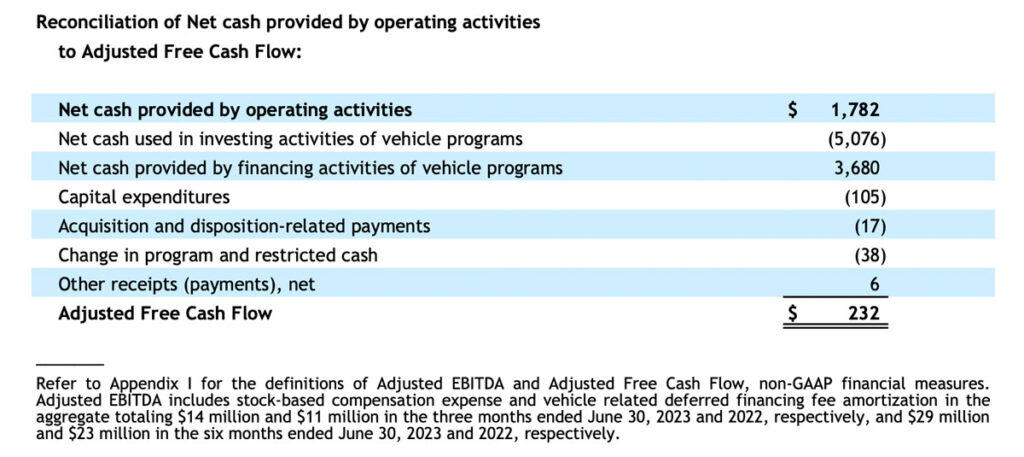
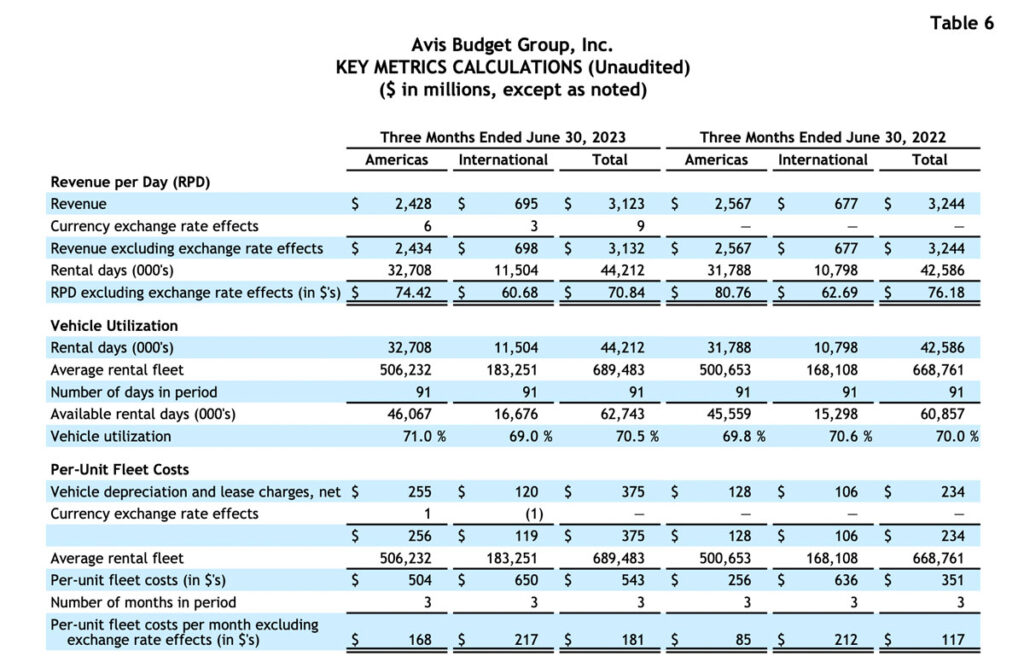
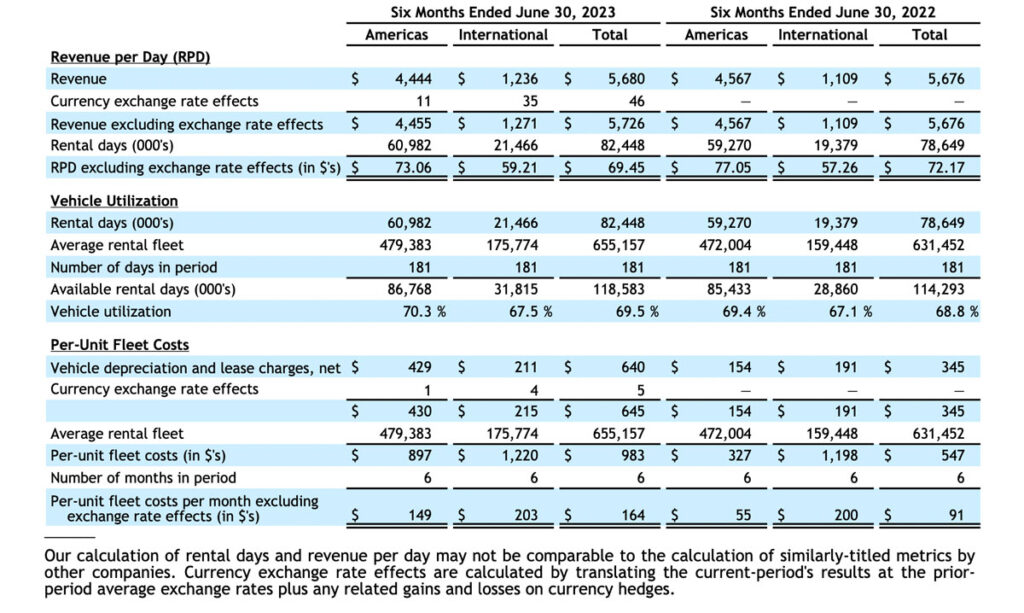
Appendix I
Avis Budget Group, Inc.
DEFINITIONS OF NON-GAAP MEASURES AND KEY METRICS
Adjusted EBITDA
The accompanying press release presents Adjusted EBITDA, which is a non-GAAP measure most directly comparable to net income (loss). Adjusted EBITDA is defined as income (loss) from continuing operations before non-vehicle related depreciation and amortization; any impairment charges; restructuring and other related charges; early extinguishment of debt costs; non- vehicle related interest; transaction-related costs, net; charges for legal matters, net, which includes amounts recorded in excess of $5 million related to class action lawsuits and personal injury matters; non-operational charges related to shareholder activist activity, which includes third party advisory, legal and other professional fees; COVID-19 charges, net; cloud computing costs; other (income) expense, net; and income taxes.
We believe Adjusted EBITDA is useful to investors as a supplemental measure in evaluating the performance of our operating businesses and in comparing our results from period to period. We also believe that Adjusted EBITDA is useful to investors because it allows them to assess our results of operations and financial condition on the same basis that management uses internally. Adjusted EBITDA is a non-GAAP measure and should not be considered in isolation or as a substitute for net income or other income statement data prepared in accordance with GAAP. Our presentation of Adjusted EBITDA may not be comparable to similarly-titled measures used by other companies. A reconciliation of Adjusted EBITDA from net income (loss) recognized under GAAP is provided on Table 5.
Adjusted Free Cash Flow
Represents net cash provided by operating activities adjusted to reflect the cash inflows and outflows relating to capital expenditures, the investing and financing activities of our vehicle programs, asset sales, if any, and to exclude debt extinguishment costs, transaction-related costs, restructuring and other related charges, charges for unprecedented personal- injury and other legal matters, COVID-19 charges, other (income) expense, and non-operational charges related to shareholder activist activity. We believe that Adjusted Free Cash Flow is useful to management and investors in measuring the cash generated that is available to be used to repay debt obligations, repurchase stock, pay dividends and invest in future growth through new business development activities or acquisitions. Adjusted Free Cash Flow should not be construed as a substitute in measuring operating results or liquidity, and our presentation of Adjusted Free Cash Flow may not be comparable to similarly-titled measures used by other companies. A reconciliation of Adjusted Free Cash Flow from net cash provided by operating activities recognized under GAAP is provided on Table 5.
Adjusted EBITDA Margin
Represents Adjusted EBITDA as a percentage of revenues.
Available Rental Days
Defined as Average Rental Fleet times the numbers of days in a given period.
Average Rental Fleet
Represents the average number of vehicles in our fleet during a given period of time.
Currency Exchange Rate Effects
Represents the difference between current-period results as reported and current-period results translated at the prior-period average exchange rates plus any related currency hedges.
Net Corporate Debt
Represents corporate debt minus cash and cash equivalents.
Net Corporate Leverage
Represents Net Corporate Debt divided by Adjusted EBITDA for the twelve months prior to the date of calculation.
Per-Unit Fleet Costs
Represents vehicle depreciation, lease charges and gain or loss on vehicles sales, divided by Average Rental Fleet.
Rental Days
Represents the total number of days (or portion thereof) a vehicle was rented during a 24-hour period.
Revenue per Day
Represents revenues divided by Rental Days.
Vehicle Utilization
Represents Rental Days divided by Available Rental Days.

